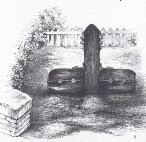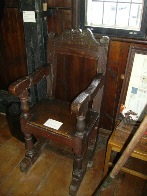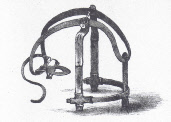Crime and Punishment in St. Mary Bourne
 The stocks and whipping post were sited between the bridge and Henry Poore's garden
fence in the Summerhaugh (Summerhaugh cottage) used to secure the hands of the offender
while being flogged.
The stocks and whipping post were sited between the bridge and Henry Poore's garden
fence in the Summerhaugh (Summerhaugh cottage) used to secure the hands of the offender
while being flogged.
The stocks were used as an ale house appendage to check brawling and drunkenness and for which purpose it was greatly in requisition during and after the time of the revel.
I was informed by an aged inhabitant some forty years ago that in his younger days he had often witnessed its employment and that "during feast times human legs were commonly to be seen protruding from the holes on both sides of the post ".
The stocks were removed from the village about the year 1850 and believed to have been used for firewood, the last person to be held in them was old John May who for many years had been the parish clerk but was dismissed for intemperance . Other stocks were sited around the parish at Swampton they adorned the green, near were the village school formally stood, at Stoke near to the blacksmiths shop, at Eggbury erected alongside the pond as filling the place of a ducking chair.
The Tumbrel or Ducking stool was in vogue for those who trespassed against the excise such as millers, bakers, and those who sold bad ale.
 Mr. S. Shaw once saw a baker drawn through the town of Andover on a hurdle for selling
bread of short weight.
Mr. S. Shaw once saw a baker drawn through the town of Andover on a hurdle for selling
bread of short weight.
Another instrument of punishment of a more unusual character, a Brank, or Scold's- of stirrup attached to the tongue plate for the reception of a strap or rein,
by which the wretched gagged creature was led about amidst the cries of a mocking
crowd. The base of the stirrup is composed of two bars, one fixing the stirrup to
the tongue-
of stirrup attached to the tongue plate for the reception of a strap or rein,
by which the wretched gagged creature was led about amidst the cries of a mocking
crowd. The base of the stirrup is composed of two bars, one fixing the stirrup to
the tongue-
- Salisbury and Winchester Journal 21st. June 1842
- Thomas Bunce charged with having on the 7th. March last at St. Mary Bourne violently assaulted John Bulpett by throwing a stone at his head.
- James Fisher for stealing a faggot from a heap belonging to William Holdway of St. Mary Bourne (James Fisher was fined 10s.)
(Kevin Holdway)
- The Salisbury and Winchester Journal Monday June 25th. 1803
- We are sorry to find that the atrocious crime of stealing children for the sake of their clothes is not merely confined to the metropolis; --- On Thursday a robbery of this kind was committed here:- A woman of the name of Shirley missed her child, a girl about four years old, in the evening (who had previously been playing with some other children) and naturally made the most diligent enquiry for her; but this proving ineffectual, great suspicion arose that the child had been stolen, which idea was soon realized, her frock, etc. being found at a pawnbrokers shop; accordingly the minutest search was immediately made to discover the infant; and the inhuman thief; a pedlars girl,. Of the name of Sainsbury, had been seen in the evening walking on the Turnpike road with a child, who was crying very much, which was supposed to be the same --- nothing certain, however, was known that night as to fate of the child, but early on Friday morning she was discovered lying asleep in a wheat field, about a mile from the city, stripped of nearly all her clothes. The above mentioned girl was taken at Otterbourne the same day, and committed for trial.
Winchester
- Salisbury and Winchester Journal Monday March 12th. 1812
- Whereas Jeremiah Marshman, of the said parish of Hurstbourne Pryors, in the county of Southampton, labourer, has absconded, leaving his wife and family chargeable to the said parish; And whereas John Marshman, late of Hurstbourne Pryors aforesaid, and his brother, an idle and disorderly person, has ran away to avoid apprehension by a warrant issued against him, Notice is hereby given, that whoever will give such information to me , so that the said Jeremiah Marshman and John Marshman may be apprehended and dealt with according to the law shall receive Five Guineas Reward from me.
Winchester
William Allee. (Overseer of the poor of Hurstbourne Pryors.)
- The Salisbury and Winchester Journal Monday Oct 17th. 1803
- At the General Quarter Sessions of the peace for this county, held here on Monday last. Sophia Simmonds was convicted of stealing several articles of wearing appararel, the property of W.Freemantle, of Whitchurch, and sentenced to be transported for the term of 7 years;
- The Salisbury and Winchester Journal Monday 10th November 1823
- Tuesday night about 11 o’clock, a barley rick suppose to contain 150 quarters, on the farm of the Earl of Portsmouth at Down Husband, was discovered to be on fire. The whole village was in danger, but by the timely arrival of the engines from the Earls mansion, and Whitchurch, the fire was got under before the whole of the rick was destroyed. It is supposed the fire was occasioned by some incendiary.
- The Salisbury and Winchester Journal Saturday February 26th 1832
- Committed for trial at Winchester Charles Pearce, for the crime of Arson committed at St. Mary Bourne on 18th. Of last November.
- The Salisbury and Winchester Journal Monday January 14th 1833
- George Wolfe a lad, for stealing two pigs from the New Forest, which he sold at Romsey fair, on the 8th. November last, was sentenced to 3 days further imprisonment, and publicly whipped in the market place.
- The Salisbury and Winchester Journal Monday February 11th. 1833
- Committed to the county gaol Sat. Feb. 2nd. 1833. Robert Waterman and Thomas Bunce, for assaulting, at the parish of Hurstbourne Priors, one Isaac Tanter, and feloniously stealing from his person a pair of leather boots, a bottle of rum, two ounces of tea, and two ounces of tobacco.
- (Saturday March 2nd. Waterman and Bunce acquitted)
- The Salisbury and Winchester Journal Monday December 28th. 1835
- An inquest was taken by Mr. Todd, on Monday last at Upham, on view of the body of Charles Churcher, an inhabitant of that parish, who died in consequence of injuries received in a fight with George Hancock, a young man also residing at Upham, on the evening of Thursday, the 10th. Inst. The contest ensued upon a quarrel which took place at a public house in the village from whence the parties adjoined to a neighbouring field, to “Fight it out “. The battle was of a very short duration, scarcely a blow was struck on either side, but the deceased was twice thrown to the ground with great violence, Hancock each time falling upon him, and although he did not first appear to have received any serious injury, he was too ill to go to work on the following day, and gradually became worse till Saturday afternoon, when he fell into a state of insensibility, and shortly afterwards expired. Upon opening his head, an extensive extravasation of blood was found upon the brain, immediately under a contusion upon the right temple, sufficiently accounting for his death.
- A verdict of “Manslaughter” was returned against George Hancock, the principal, and Thomas Cooper and James Pearce, the two seconds, who were immediately committed for trial at the next Assizes.
- Committed for trial – charged with George Hancock, for killing and slaying, at Upham, one Charles Churcher, and Jas. Pearce and Thomas Cooper, for aiding and abetting the said George Hancock.
- The Devizes and Winchester Gazette Monday January 18th. 1833
- Horrid Murder.
- An inquest was last week held at Hurstbourne Tarrant, between Andover and Newbury, on view of the body of a woman unknown, who had been travelling as the wife of William Rose, a pedlar and itinerant dealer in spice, well known in the neighbourhood. The following is an abridgement of the material parts of the evidence: - Ann Warwick, a labourer's wife, deposed that Wm.Rose came to their cottage for assistance at about 10 o'clock last Friday evening, the 1st of November, stating "that he had got a woman very ill up in the lane, and that he supposed she had fits, as she was almost mad, and he thought she had breathed her last." Rose appearing sober and sensible at that time, witness called a young man out of the stable, and hastened with him and Rose to the spot, being the corner of a lane called Locksdrove, about 300 yards from Warwick's cottage. There they found the body of the deceased woman, lying on her back, quite dead, with no bonnet or cap on her head, no shoes on her feet, her hair disordered, and marks of violence on her hands and face. - Witness directly called further assistance, and the body being removed, a quantity of blood was discovered on the ground beneath it.
Mr. John Vincent Medhurst, a surgeon, deposed that he was called to examine the body at about twelve o'clock last Friday night, and immediately hastened to the spot. He found the body lying as described by Mrs. Warwick, and William Rose lying on the ground just by, apparently half asleep. Rose, upon being aroused and questioned about the woman said "he had found her struggling in a fit about five o'clock in the evening." The extremities of the body were cold, but not the trunk, and it appeared to have been dead about two or three hours. That night and the following day witness minutely examined the body, and discovered the following injuries :- several contused wounds on the head, back, sides, legs, and arms; laceration of the scalp; fracture of the small bone of the right leg; abrasion of the skin in several places; a deep stab with some blunt instrument in the lower part of the abdomen, extending into the pelvis in two directions; concussion of the brain; nine ribs broken, three of them in two places each; laceration of the lungs and costal arteries; with extensive extravasation of blood in the head and chest. All other parts of the body were healthy and uninjured. Witness has no doubt that the above injuries of the head and chest caused the woman's death. She appeared to be a healthy woman of about 50 years of age..
Henry Francis North, a maltster, deposed that at six o'clock last Friday evening he was passing near Locksdrove-lane, when he heard a man in the lane say, "Be you coming?" and a woman replied in a strong tone of voice, "I can't." When he got opposite the drove, he saw a man beating a woman with a stick very severely, as she lay on the ground, begging for mercy. Upon returning that way in about half an hour with his sister, they met Wm.Rose, with a pack at his back and a stick in his hand, and saw him turn up Locksdrove-lane, immediately after which they heard the same question and reply as before, followed by two very hard blows, and a woman begging for mercy. Witness saw no one else about except the said man and woman and his sister. It was nearly dark at the time..
Charles Green, a labourer, deposed, that about half-past five last Friday evening he was passing near Locksdrove-lane, and saw William Rose lifting a woman off the ground, near the entrance of the lane. She said she could not get up, upon which Rose called he "a nasty drunken ----," and threatened to beat her. He had a staff in his hand.
William Wright, a boy about ten years of age, and Thomas Smith, a woodman, deposed, that they passed down Locksdrove-lane at about six o'clock, last Friday evening, and saw a man resembling Wm.Rose, beating a woman with a large stick, apparently as hard as he could hit her, while she was upon her hands and knees. The woman cried "Murder." Elizabeth Cook, a girl about thirteen years of age, deposed, that she was going by Locksdrove-lane at about a quarter before six last Friday evening, and heard a woman cry "Murder !" When witness got opposite the drove, she heard a man say, "---- your eyes, I will kill you!" and at the same time saw a man exactly resembling Wm. Rose whom she had seen go into the drove about an hour before, with a pack on his back, fumbling a pack about under the hedge, and a woman lying on the ground just by, upon her back, quite still, as if dead..
Thomas Smith, the younger, a woodman, deposed that he found a large walking stick, in a field adjoining Locksdrove-lane, soon after daylight last Saturday morning: one end of it was broken off in splinters, and it was stained with blood. Wm.Rose saw it, and immediately said, "This is my stick.".
Upon the evidence, the jury without hesitation returned a verdict of "Wilful Murder" against Wm.Rose, who was immediately committed by the Coroner for trial at the next assizes. The prisoner appears to be a strong healthy man, of about seventy years of age, and looks like a gipsy..
In addition to the above story this was recorded in the Lancaster gazette and General Advertiser November 16th 1833..
When the verdict was announced to him he laughed, and said “Very Well”. Upon being asked if he had anything to say for himself, or any questions to put to either of the witnesses, he replied “ Not at present”, and appeared perfectly devoid of feeling, but by no means destitute of cunning, as exemplified to every part of the proceedings..
The learned judge in summing up, .
The jury in a few minutes brought in a verdict of “Guilty”, upon which his Lordship put on the black cap, and passed sentence on the prisoner in the following terms;
Prisoner at the bar, the jury, after a very patient and attentive consideration of the evidence that has been adduced against you today, have found themselves under the necessity of
coming to the conclusion that you have been guilty of this crime; and I am quite sure, that not only myself, but that no person present who has heard the testimony adduced,
can entertain any doubt whatever but that you have been guilty of this high crime of murder. It is not my intention to aggravate your feelings by a description of the train and course of
the injuries which you appear for a length of time to have inflicted on this unhappy, unoffending, and helpless woman; all that no doubt your conscience suggests to yourself,
and I should be much better engaged, as it is my intention to be in recommending to you to employ the few hours that now remain for you to live, in that hearty and sincere contrition and
repentance which your unhappy condition does most loudly call for. Much as we all stand in need of it, surely none stands more in need than a person who has imbrued his hands in the blood of
a fellow creature, and not merely so, but according to your own account, in the blood of your own wife. I do entreat you, therefore, during the very short time you now have to live,
to think of that account to which you are now hastening and to make use of it by that sincere sorrow and perfect repentance which may meet with acceptance elsewhere, for at the hands
of a human tribunal, mercy you will not receive .
The learned judge then sentenced the prisoner to be executed on Monday next, and his body to be buried within the precincts of the gaol.
On Monday last, the extreme penalty of the law was carried into effect, on the new drop behind the County Gaol, on William Rose, aged 74,
who was tried and convicted, at the Assizes last week, of the murder of a woman then unknown, but whom he afterwards admitted was his wife.
The prisoner had behaved with the greatest indifference since his condemnation. The "Rideing Hood" was used as a cover to paupers and others, to be worn on the removal
from the parish. They were generally conveyed on the backs of horses, seated on a
pillion. The roads being unfavourable for vehicles, the farmers used the pillion
for their wives, who sat behind them carrying their market produce in their laps.
The poor often suffered terribly in being driven about to find their parishes; and
were sometimes whipped through the streets, and even died during removal. "Burn's history of parish registers" furnishes a curious example of this. The entry
states: "1578, there was comytted to the earth the body of one Johan Longley, who
died in the highway as she was carried on holyback to have been conveyed from officer
to officer, tyll she should have come to the p'ishe of Rayershe". Does "holyback"
mean horseback, or that she was conveyed on the backs of the officers? (Dr. Joseph
Stevens)